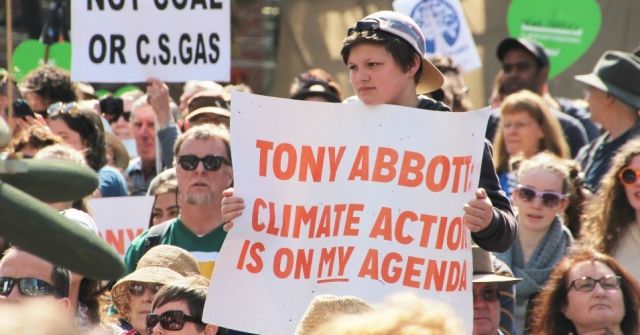
With the Paris climate talks just around the corner it is timely to consider what effective policies to cut emissions might look like. Nationalisation and direct public investment are key policies that have historically been “bread and butter” political demands both for socialists and for the more radical voices within social democratic parties.
Climate activists from the Greens and Labor Environment Action Network should revisit these ideas, as they are a useful alternative to the dead end that is carbon trading.
Direct public investment
Every large coal-fired power station in Australia is a product of direct public investment by various state governments. So too is our largest renewable power plant, the Snowy Hydro Scheme. Clearly direct public investment in electricity generators is not a pie-in-the-sky utopian fantasy.
Before the Victorian power industry was privatised in the 1990s, the State Electricity Commission of Victoria (SECV) had managed to deliver electricity at steadily declining prices in real terms while maintaining reliable and safe supply.
We know that in 2015 wind turbines and solar photovoltaics are cost competitive with coal and gas and represent a wise investment with guaranteed returns. Large scale solar thermal plants with storage will fall in price when they are mass produced, with independent modelling showing the cost of these plants will fall once a few gigawatts are built.
Put simply, we can be sure that if state and federal governments invest public money in wind and solar, they will be delivering a revenue-generating asset that can deliver cheap power for all for decades to come. Given that the best locations for wind farms and solar parks are in rural areas, this will also bring much needed jobs and economic activity to these areas.
Of course, every wind farm and solar plant built and run by publicly-owned power companies is one that will not be run for profit by a private energy company. On top of this, publicly built and owned renewables will push existing coal-fired power stations out of the market.
But while the corporations that run power stations — coal-fired or renewable — don't like the idea of government investment in renewables, it is arguably the quickest way to get large amounts of renewables built.
Unlike ineffectual and eminently corruptible carbon trading schemes, actually building large amounts of renewable generation and pushing coal-fired power stations permanently out of business erodes and degrades the power base of the fossil fuel lobby.
A government can implement a carbon trading scheme and have little to show for it after five or ten years, even if a conservative government does not get voted in and abolish the scheme entirely, as Tony Abbott did with the Julia Gillard government's carbon price. Physical wind and solar plants are a lot harder to “abolish” once built.
Nationalisation
Australia is the world's largest coal exporter, with coal our largest single export in dollar terms. Coal causes climate change. Tens of billions of dollars will have to be invested in reconfiguring the Australian economy to ultimately eradicate our reliance on coal as a source of employment and export revenue.
The question needs to be asked: why are corporations still allowed to profit from this industry? The cost of dealing with the amount of warming currently locked into the global climate system is massive. The cost of remediating old mine pits across the country is similarly vast.
On top of this, the global coal market is oversupplied, with the result that coal prices have fallen through the floor and many coalmines and mining corporations are chalking up big operating losses. As the world moves to renewables, the coal industry is entering “structural decline”.
When the global financial crisis hit in 2008, banks and corporations were taken over by governments — nationalised — to prevent a potential domino effect if any of these corporate behemoths collapsed. General Motors, mortgage lenders Fannie Mae and Freddie Mac, British bank Northern Rock and the entire Icelandic banking sector were among the entities nationalised.
Why not nationalise Australia's coalmines and related infrastructure, re-nationalise our coal-fired power stations and implement a planned phase-out program over a decade or so? No doubt decades from now governments will be trying to collect compensation for the growing climate change damage bill from those who received, and most likely hid in offshore accounts, the profits of coal. Why not cut to the chase?
In Venezuela, the oil industry was re-nationalised and revenue from the industry has been used to fund a raft of poverty reduction programs. Australia does not have the grinding poverty and illiteracy of Venezuela, so the profits gained from the nationalisation of coalmines and phase-out of coal exports could be invested in alternative employment programs in coal-reliant communities.
By reducing our exports the current oversupply of coal would be reversed and the price per tonne would be pushed back up, providing funds for the phase-out.
Nationalising the Venezuelan oil industry was not easy. The political establishment attempted a military coup and was only prevented from succeeding by the working people of Caracas spontaneously descending on the Venezuelan parliament to demand their democratically-elected government back.
It is a sure bet that the Australian political establishment would be similarly furious at the nationalisation of the Australian coal industry as part of a plan to phase it out, and by a massive program of public investment in wind and solar. Bring it on. It is the battle we have to have — and win. Climate activists need to embrace and own the revolutionary implications of replacing coal with renewables.
If Australia is to transform itself from climate pariah into a catalyst for global action to prevent catastrophic warming, the transition must necessarily be radical. A decades-long carbon trading scheme that, in a best case scenario, slowly delivers some small reduction in emissions is little better than the coal-fired status quo.
Like the article? Subscribe to Green Left now! You can also like us on Facebook and follow us on Twitter.